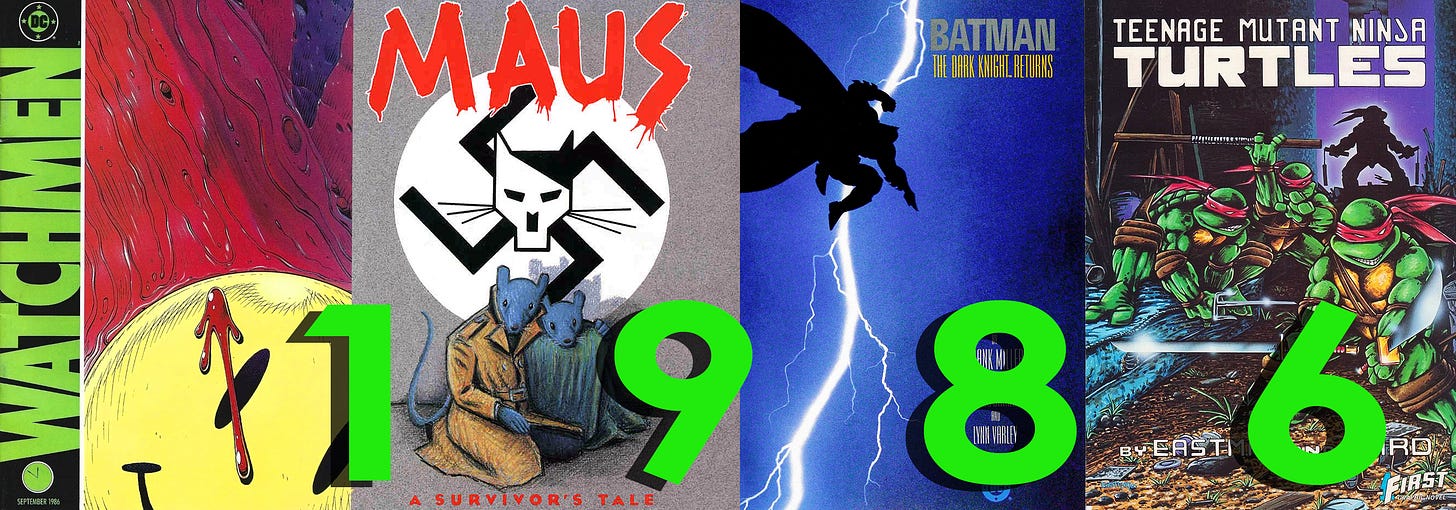Brandon Keaton’s new Substack goes out to 66 subscribers in 4 countries. Become a paid supporter to access every jot and tittle—and embrace the knowledge that you’re supporting an independent writer fighting for truth, justice, and the Gotham City way.
“Beyond evil there is insanity. Beyond insanity is… the Joker.”
Whether you’re looking to wet your whistle on your first-ever Joker tale, or if you’ve just got a hankering for something slightly off the beaten path, you wouldn’t do wrong to nab a copy of Batman: The Killing Joke. Originally retailing for $3.50 USD in 1988, it can now can be found online in various hardcover editions, none of which are without merit.
But before we delve into the story (I’m keeping spoilers at a minimal for the unitiated) please allow me to set the scene ever so slightly… Two years prior the comic book world changed dramatically with glossy new prestige format releases like Watchmen and The Dark Knight Returns. I remember seeing the latter of those two hanging up behind the counter at my local comic book store and being totally hypnotised by the cover.
Redesigned heroes of yesteryear, anthropomorphic characters, and darker plotlines were out to appeal to a fan base that outgrew their newsstand comics. This new wave of publications caught up with its ever-aging readership by becoming more graphic, gritty, and grown-up… and the heftier price tags associated with these books perhaps elevated them to a higher level of repute.
The Killing Joke, clearly for mature audiences, is no exception.
The book opens on a stormy (what else?) night as the Batmobile rolls up outside the gates of Arkham Asylum. Batman marches down a series of halls—ignoring several recognizable rogues along the way—before coming to the door of an unknown prisoner. Once inside, Batman speaks somberly to his alabaster archenemy about where the pair seem to be headed should they continue down their chosen paths.
So begins what may ending up being the Joker’s final reign of terror. The clown’s plan is to get at Batman by kidnapping Commissioner Gordon, and then to bring the commish teetering over the brink of lunacy. Keen eyes might notice this part of the narrative was later borrowed upon by Christopher Nolan’s Dark Knight wherein the Joker seeks to corrupt Gotham’s district attorney Harvey Dent.
Interspersed between Batman’s occasional brooding and Joker’s carnivalesque machinations are pitiable glimpses into the villain’s past. Prior to his disfigurement, Joker was apparently a dad-to-be and (surprise, surprise) an aspiring stand-up comedian.
With his personal life seemingly in shambles, he linked up with a couple of unsavory characters in an effort to make some money and thereby prove himself a worthy husband and provider. This proves disastrous later on.
Cut to the present where Joker commits an appalling series of violations against Jim Gordon’s daughter, Barbara. This is the part of the book that requires a relatively strong constitution on the reader’s part because, let me tell you guys and dolls, the depths of Joker’s sadism are on full display here.
I don’t want to spoil it for anyone, but suffice it to say several pages depict one of the more brutal treatments of a female I’ve ever seen in printed material. Oddly enough this vile series of events is also what makes a character like Joker so damn compelling—he’s almost impossible to anticipate, even for the Dark Knight Detective—and that makes him all the more fascinating and frightening.
By the time Batman figures out what tricks the Joker has left up his sleeve, it’s almost too late. As the book barrels toward an inevitable showdown, it is Gordon himself who pleads with Batman to “do the right thing.” For a few beautiful and haunting moments we see a more sensitive Caped Crusader imploring the Joker earnestly, and the story ends on a note that one might not expect.
Masterfully illustrated by Brian Bolland and penned by Alan Moore, these two figures from the pantheon of comic book royalty are utterly fearless in showing us how one bad day could turn any Average Joe into the maniacal Clown Prince of Crime.
Trust me when I say this book isn’t for the faint of heart. But perhaps that’s exactly the reason why in the thirty plus years from its original publication date that The Killing Joke still exhibits so much chutzpah.
Verdict: 5 bats out of 5 🦇










Probably the best Joker story ever